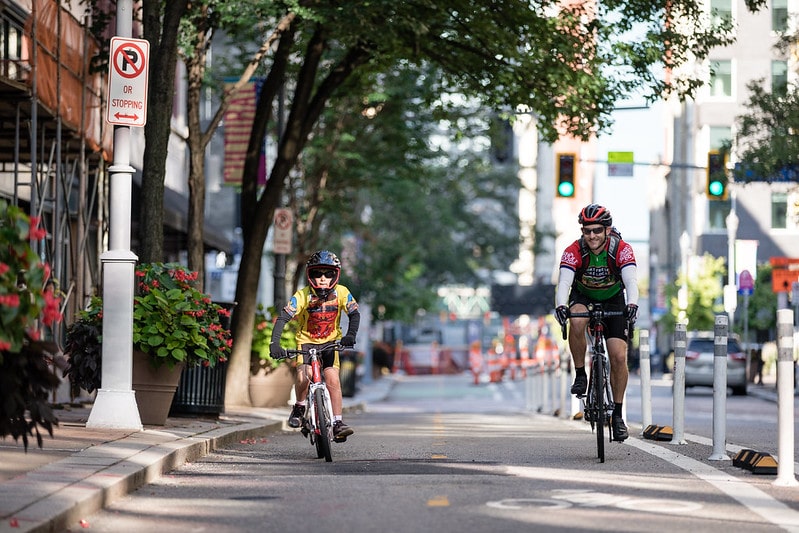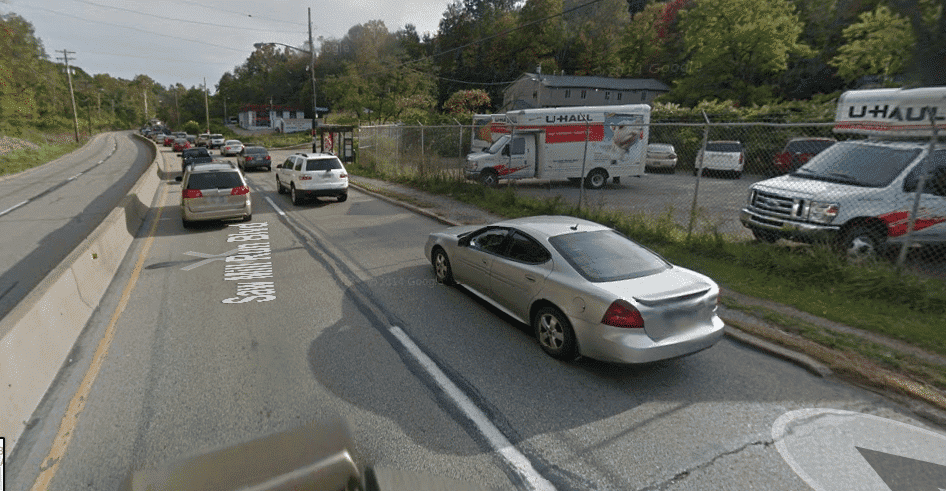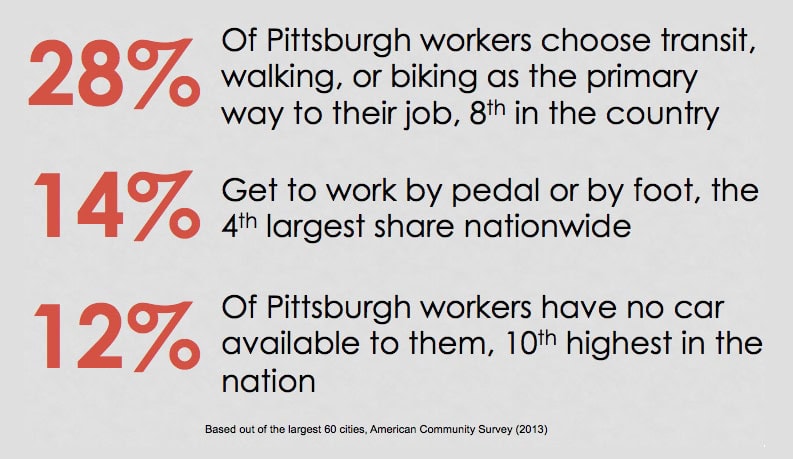Complete Streets

BikePGH is Leading the Charge for Complete Streets in Pittsburgh & beyond
Beginning at our 2014 Member’s Meeting, Bike Pittsburgh launched our push for Pittsburgh to adopt a Complete Streets Policy.
On April 10, 2015, Mayor Peduto issued an Executive Order on a Complete Streets Policy for Pittsburgh Rights of Way. Recognizing that Pittsburghers get around in many different ways, this Order directs his staff to use Complete Streets philosophies in their work and calls for the creation of a Complete Streets Advisory Group to work on creating a more robust Complete Streets Policy that can be enshrined into law.
Since then, there have been over a dozen Complete Streets policies , resolutions and ordinances enacted in the region, including a 2024 policy for the Southwestern Pennsylvania Commission.
Two direct results of Pittsburgh’s Complete Streets Policy include:
- City of Pittsburgh’s Complete Streets Program Page.
- City of Pittsburgh’s Complete Streets Advisory Group (CSAG) page.
If Pittsburgh is to grow in population, we need to be smart in how we plan this growth in order to avoid increasing the already congested and dangerous roads. Everybody, regardless of who they are, where they live, or how they get around, should have the choice to travel in a safe and convenient manner. This simple vision will require those who are making decisions about our transportation network to plan ahead and put the policies and the laws in place to ensure it.
- February 2025: Allegheny County Council passes an ordinance directing the Allegheny County Economic Development office to develop a strong Complete Streets Policy for the County by December 31, 2025
- October 2024: The Southwestern Pennsylvania Commission passes a Complete Streets Resolution
- October 2023: City of Pittsburgh restarts their community-driven Complete Streets Advisory Group (CSAG)
- September 2024: Churchill Borough passes a Complete Streets Policy
- June 2023: Dormont Borough Passes a Complete Streets Policy
- November 2022: Mt Lebanon Passes a Complete Streets Policy
- June 2022: Forest Hills Passes a Complete Streets Policy
- September 2019: Wilkins Township Passes a Complete Streets Policy
- September 2018: Millvale and Etna Pass Complete Streets Policies
- July 2017: Sharpsburg Borough passes Complete Streets Policy
- November 21, 2016: Pittsburgh City Council passes the Complete Streets Policy!
- July 2016: Planning Commission unanimously approves the Draft Complete Streets Policy, recommends that Pittsburgh City Council approve it
- July 2016: Dept of City Planning releases Draft Complete Streets Policy
- December 2015: Dept of City Planning hosts Complete Streets Policy Public Meeting, attracting over 200 participants
- April 2015: Pittsburgh CONNECT Communities Pass Complete Streets Resolution
- April 2015: Mayor Peduto Issues Complete Streets Executive Order
- November 2014: We officially launch our campaign to get a Complete Streets Policy for the City at our Member’s Meeting
A brief history and appeal to other Allegheny County Municipalities
Even before getting elected, Mayor Peduto consistently talked about the importance of “Complete Streets” for Pittsburgh, and stating (in our 2013 candidate survey) that he wants “a comprehensive complete streets policy that becomes incorporated into the policies and procedures of every relevant department in the city.” and that “we need a real institutional commitment to complete streets that allow people to feel safe enough to walk or bike to work.”
Additionally, Mayor Peduto’s Transition Team recommendations included the adoption of Complete Streets Policies and an Advisory Committee.
Interested in a Complete Streets policy for your community? Contact us or the Southwestern Pennsylvania Commission.
The streets of our cities and towns are an important part of our communities. They allow children to get to school and parents to get to work. They bring together neighbors and draw visitors to neighborhood stores. These streets should to be designed for everyone – whether young or old, on foot or on bicycle, in a car or in a bus – but too often they are designed only for speeding cars or creeping traffic jams.
In communities across the country, a movement is growing to “complete” the streets. States, cities, and towns are asking their planners and engineers to build roads that are safer, more accessible, and easier for everyone. In the process, they are creating better communities for people to live, play, work, and shop.
Complete Streets are streets for everyone. They are designed and operated to enable safe access for all users. Pedestrians, bicyclists, motorists, and public transportation users of all ages and abilities are able to safely move along and across a complete street.
Complete Streets make it easy to cross the street, walk to shops, and bicycle to work. They can help buses to run on time and make it safe for people to walk to and from stops and stations.

Saw Mill Run Blvd, or Rt 51. A complete streets policy would have helped make sure that there were sidewalks installed when the road was designed.
In contrast, “incomplete streets” – those designed with only cars in mind, limit transportation choices by making walking, bicycling, and taking public transportation inconvenient, unattractive, and, too often, dangerous.
Pittsburgers want choice
A complete streets policy ensures that transportation planners and engineers consistently plan, design, operate, and maintain the entire roadway and roadway networks with all users in mind – including bicyclists, public transportation vehicles and riders, and pedestrians of all ages and abilities in order to maximize transportation choices.

Pittsburgh has a large network of sidewalks, slow narrow streets, and density, resulting in a healthy mix of active transportation. However, pedestrian and bicycle injuries continue to climb, buses must still sit in traffic, and there are major gaps in the network. Some new developments and road projects have the potential to exasperate these gaps.
Solution: Complete Streets Policy
Complete Streets are streets for everyone, no matter who they are or how they travel.
This is what complete streets is about – making sure our transportation network works for all users every time there’s a new project. Complete Streets policies formalize a community’s intent to plan, design, operate and maintain streets so they are safe for all users of all ages and abilities. Policies direct decision-makers to consistently fund, plan, design and construct community streets to accommodate all anticipated users, including pedestrians, bicyclists, public transit users, motorists and freight vehicles.
Complete Streets puts the onus on these decision makers to show why all modes can’t be accommodated, as opposed to the community needing to prove why the accommodation is necessary.
Creating complete streets means transportation agencies must change their approach to community roads. By adopting Complete Streets policies, communities direct their transportation planners and engineers to routinely design and operate the entire right of way for all users. This means that every transportation project will make the street network better and safer for drivers, transit users, pedestrians, and bicyclists and city in general.
Complete Streets does not mean:
- One ‘special’ street project
- A design prescription
- A mandate for immediate retrofit
- A silver bullet; other issues must be addressed: Land use (proximity, mixed-use), Environmental concerns, Transportation Demand Management
Complete Streets policies are an important piece to ensure our streets are accessible to everyone. It’s about changing the way we approach transportation projects on all streets, not just one project. Implementation of Complete Streets is flexible and context-sensitive and doesn’t mean all roads have to be changed all at once. Changes can be made a little at a time and done along with routine maintenance. Complete Streets won’t address all concerns, which will still need attention.
The movement is not limited to states or large cities; communities of all sizes find these policies valuable. More than one-third of all policies were adopted in suburban communities of fewer than 30,000 residents. Small towns, often in rural areas, are well represented: nearly one in five of all Complete Streets policies were adopted in these jurisdictions.
In the long run, retrofit projects always cost more than getting it right the first time.
Early multi-modal planning saves money by avoiding costly project delays. Without a policy, bicycle, pedestrian, and public transportation accommodations are often debated too late in the design process and are considered a disruption rather than necessary and beneficial project features. This creates expensive design revisions, time delays, and erodes public support. Furthermore, the failure to accommodate these user groups can trigger an expensive retrofit project at later date.
In taking a comprehensive approach to transportation planning, a Complete Streets policy addresses systematic inequalities to ensure that neighborhoods across the socioeconomic spectrum have safe places for people to walk, ride bicycles, use transit, and drive automobiles. Often, neighborhoods with more political clout and wealth, will be the first to see improvements to their built environment. Adopting a policy demonstrates a community’s intention to improve quality of life for all its citizens, regardless of their neighborhood.
Progressive transportation advocates need supportive high-level officials and decision makers. Without that support, our input is often marginalized. Going through the process of developing Complete Streets policies, educating the elected officials and community – and others in the DOT – helps give us the political and community support that we need.
It also makes fiscal sense. A Complete Streets approach helps every transportation project achieve more with less by providing multiple community benefits. Many of the ways to create more ‘complete’ roadways are low cost, fast to implement, and high impact.
What does a Complete Streets Policy look like?
Policies take many forms, from simple resolutions to detailed Transportation Master Plans, changes in zoning, and design manuals. While there is no one way to create a “cookie cutter” policy, most cities start by framing “complete streets” through legal ordinance, resolution, and/or executive order.

There is a spectrum of good and bad complete streets policies. Some are simply a statement with no teeth, while others may change the zoning code, or create official advisory committees. Smart Growth America’s National Complete Streets Coalition (NCSC) scores every Complete Streets policy enacted based on 10 technical policy elements.
The NCSC was founded in 2005 by a variety of advocacy and trade organizations including AARP, the American Planning Association, the American Heart Association, and the American Society of Landscape Architects.